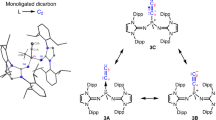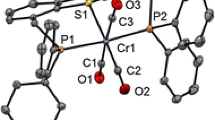Abstract
Reactions of 1,2,5,6,8,10-hexamethylheptalene (1) and its bond isomer, 1,4,5,6,8,10-hexamethylheptalene (2), with tricarbonylchromium complexes L{in3}Cr(CO){in3} (L=NH{in3} and Py) have been investigated. Thermodynamically less stable complex 1 exhibits higher reactivity with respect to Py{in3}Cr(CO){in3}/BF{in3} · Et{in2}O under the conditions of Öfele's reaction than complex2. At 10–30 °C, the Cr(CO){in3} group is coordinated to the asymmetrically substituted ring, which is accomplished by the shift of double bonds in the ligand, to afford tricarbonyl-[1,4,5,6,8,10-hexamethyl-η{su6}-(10a, 1–5)heptalene]-chromium (6) as the only mononuclear complex. Under more drastic conditions (Raush's reaction, 80 °C),1 ↔ 2 interconversion proceeds faster than the reaction of individual bond isomers with coordinatively unsaturated “hot” particles (solv){inn}Cr(CO){in3}. In this case, all of the four possible isomeric mononuclear complexes (6–9) and two binuclear complexes (10 and 11) are formed. The structures of complexes 6–11 have been studied by NMR and mass spectrometry, the structure of6 has been established by X-ray diffraction analysis. Heating a solution of6 in octane at 115 °C results in the isomerization of6 into complex7 through the intracycle 1,2-shift of the Cr(CO){in3} group and also in its conversion into complex8, which is the first example of interring η{su6}→η{su6}-haptotropic rearrangement in nonplanar seven-membered π-systems.
Similar content being viewed by others
References
H. J. Dauben and D. J. Bertelli,J. Am. Chem. Soc., 1961.83, 4659.
E. Vogel. H. Konsigshofen, J. Wassen, K. Mullen, and J. F. M. Oth,Angew. Chem. Int. Ed. Engl., 1974,13, 732.
H. J. Lindner and B. Kitshke,Angew. Chem. Int. Ed. Engl., 1976,15, 106.
J. Stegemann and H. J. Lindner,Tetrahedron Lett., 1977, 2515.
K. Hafner and G. L. Knaup,Tetrahedron Lett., 1986,27, 1665.
K. Hafner, N. Hock, G. L. Knaup, and K.-P. Meinhardt,Tetrahedron Lett., 1986,27, 1669.
J. F. M. Oth, K. Mullen, H. Konigshofen, J. Wassen, and E. Vogel,Helv. Chim. Acta, 1974,57, 2387.
K. Hafner, G. L. Knaup, H. J. Lindncr. and H.-C. Floter,Angew. Chem. Int. Ed. Engl., 1985,24, 212.
G. Gottarelli, H.-J. Hansen, G. P. Spada, and R. H. Weber,Helv. Chim. Acta. 1987,70, 430.
R. H. Weber. P. Brugger, T. A. Jenny, and H.-J. Hansen,Helv. Chim. Acta. 1987,70, 742.
R. H. Weber, P. Brugger, W. Arnold, P. Schonholzer, and H.-J. Hansen,Helv. Chim. Acta. 1987,70, 1439.
K. Hafner, G. L. Knaup, and H. J. Lindner,Bull. Chem. Soc. Jpn., 1988,61, 155.
W. Bernhard, P. Brugger, J. J. Daly, G. Englert, P. Schonholzer, and H.-J. Hansen.Helv. Chim. Acta, 1985,68, 1010.
E. Vogel, D. Kerimis, N. T. Allison, R. Zellerhoff, and J. Wassen,Angew. Chem. Int. Ed. Engl., 1979,18, 545.
J. Stegeman and H. J. Lindner,J. Organomet. Chem., 1979,166, 223.
K. Mullen, N. T. Allison. J. Lex, H. Schmickler, and E. Vogel,Tetrahedron, 1987,43, 3225.
C. E. Keller, G. F. Emerson, and R. Pettit,J. Am. Chem. Soc. 1965,87, 1388.
M. I. Bruce, M. Cooke, and M. Green,J. Organomet. Chem., 1968,13, 227.
J. Campbell, C. A. Fyfe, and E. Maslowsky,J. Am. Chem. Soc., 1972,94, 2690.
K. Ofele,Chem. Ber., 1966,99, 1752.
M. D. Rausch, G. A. Moser, and E. J. Zaiko,J. Organomet. Chem., 1970,23, 185.
M. Louer, G. Simonneaux, and G. Jaonen,J. Organomet. Chem., 1979,164, 235.
Author information
Authors and Affiliations
Additional information
Translated fromIzvestiya Akademii Nauk. Seriya Khimicheskaya, No. 12, pp. 2220–2226, December, 1994.
We would like to thank N. S. Kulikov for measuring mass spectra and L. A. Aslanov for helpful discussion of the results of X-ray diffraction analysis.
The Research Group from the Moscow State University gratefully acknowledges the support of this work by the International Science Foundation (Grant No. MQ 5000) and the Russian Foundation for Basic Research (Project No. 94-03-08325).
Rights and permissions
About this article
Cite this article
Ustynyuk, Y.A., Trifonova, O.I., Yatsenko, A.V. et al. Synthesis, structure, and rearrangements of new tricarbonylchromium complexes of substituted heptalenes. Russ Chem Bull 43, 2100–2106 (1994). https://doi.org/10.1007/BF00700179
Received:
Issue Date:
DOI: https://doi.org/10.1007/BF00700179




